Specimens and proofs
Terminology
Many people come to scripophily with experience in other collecting hobbies. There is usually some terminology in common, but accepted meanings in the stock and bond hobby may differ. The closest definitions are probably those used by collectors of paper money. (See a good collection of definitions by Paper Money Guaranty Corporation: "PMG Glossary.")
The definitions of "proof" in the scripophily hobby is in line with that in the printing business, but differs from the term used by coin and currency collectors. Proofs related to stocks and bonds were physical captures of certificate designs at various points in the process between design and final production. During that process, engraver and printers often "pulled" several proofs to check appearance and reproduction ability. To engravers, proofs were usually nothing special. Most were merely working drafts and check prints prior to formal production. The great wonder with proofs is how ANY survived the rubbish bin.
By contrast, "specimens" captured the exact finished appearance of certificates at the time documents became full-fledged securities. They were printed on the same presses with the same plates at the same time and using the same paper as production-run certificates. They were simply marked differently to indicate they were not intended for issuance as valid securities. Proofs and specimens are somewhat like pictures in family photo albums: they are snapshots of financial documents at different points in their life spans.
With very rare exception, paper documents have disappeared from North American securities' markets. Consequently, this article and most others on this website refer to the production of stocks and bonds in the past tense.
Models and mock-ups
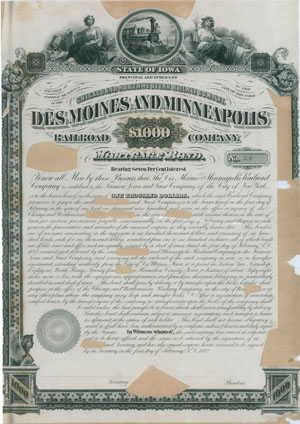
The first step in the creation of a security began when company organizers and officials decided to try to raise money through the sale of company stock or by borrowing money through the issuance of company bonds. At some point, ideas were committed to paper and the design process began. Examples of the very earliest stages of designs are very rare.
Designs sometimes started with pencil designs on blank sheets of paper. At other times, a person started with an existing stock or bond and marked it up with pen and pencil. Occasionally, parts of pre-existing certificates were cut out and pasted onto other certificates. In a few cases, organizers dismembered pre-existing certificates and reassembled the parts with paste as "models" to begin new designs. Auction catalogs generally refer to such efforts as "mock-ups."
Regardless of name, all are unique! Models and mock-ups are hard to find and commonly collected by specialists. Because they were not printed, they don't really qualify as "proofs" per se. Nonetheless, they are evidence of baby steps on the way between concept and production, so this project groups them under the broad definition of proofs.
Proofs
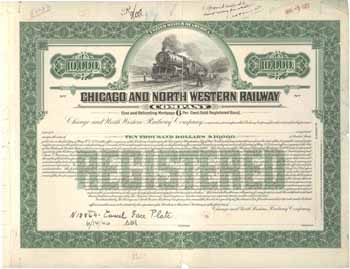
Initial designs might have been laid out by founders or company employees. The larger the client company, the more likely that major engraving/printing firms would have assigned one of their employees to the task. All subsequent revisions, modifications and productions were completed by printing and engraving companies.
There were many design considerations between conception and production. Every step was subject to a certain level of trial and error. Every element of a certificate – from vignette to borders to text – needed consideration, design, execution, testing and refinement. If a custom vignette was desired, new artwork would have been required. Next came engraving and etching. Since securities were going to acquire high value upon issuance and subsequent trading on stock exchanges, sometimes in multiple countries, designs needed to comply with regulatory issues and anti-forgery recommendations. No step was trivial and most design steps needed management decisions and approvals by client companies, sometimes along with legal input.
Shown above is a proof of the face of a $10,000 bond issued by the Chicago & North Western Railway in 1920. This uniface example required two plates: one for the text and another for the green border. This is an "orphaned" proof meaning no other examples (issued, unissued, or specimen) have been reported.

At right is an enlargement of the text in the top margin. It shows that the treasurer for the C&NW signed the proof on November 1, 1920 and says, "Approved subject to adding punctuation."
Many start-up companies needed to side-step the expense of custom-designed stock certificates and used generic certificates instead. Those were pre-printed certificates that could be purchased from printers and ordinary stationery stores. Companies merely needed a local printer to overprint company names, par values and possibly capitalization amounts. Once the ink dried, companies could start selling stock. Some companies did not even go to the expense of hiring a printer and simply hand-wrote or typed those details. Generic bonds were also used, but only a few examples have appeared.
Some generic certificates were dreadfully plain. The most widely-seen examples are vignetted, usually sold with empty panels reserved for company names. Larger, more profitable companies eschewed generic certificates in favor of custom designs. After all, custom designs implied greater stability and companies meant business "for the long haul." There was significant promotional value in securities that sported custom designs and superbly-engraved vignettes.
While easily overlooked, every step in the custom design process needed real-life testing to see how borders, text and vignettes would print. Most "test proofs" were examined and quickly discarded even before the ink was dry, so only small numbers survive. Each is almost always different from every other. In the early stages of the design process, textual mistakes were common and many proofs show handwritten corrections. Not every vignette looked perfect on paper and not every vignette passed muster with company executives. Company managers did not necessarily like every color choice, either. No one knows how many proofs might have been "pulled" during the creation of a typical new security, but there were certainly a few for every plate and some certificates required many plates.
A typical stock certificate with a colored border would have required three, sometimes four, plates: one plate for the colored border, one for static text and vignette on the front and one for text on the back. If the stock certificate was fairly modern, a second black plate would have been prepared for the front in order to accommodate frequent changes in facsimile signatures of company officers, registrars and trust companies.
Typical bond issues would have required even more plates, depending on whether it was necessary to print bonds in both registered and bearer form and the number of different denominations desired for issuance. In the case of some of late-date New York Central and Pennsylvania Railroad bond issues, plates of any given series might have numbered as many as ten or more plates. One can only imagine how many proofs were produced and destroyed for issuances like that.
Only a miniscule number of proofs survive today In spite of the number created during the design phase. Moreover, proofs were often printed on cheap porous card stock that broke after a few refoldings. Many proofs were printed on India paper that reproduced etched details extremely well but crumpled easily in file drawers. Never mind that no engraving company had the space to keep every proof produced for every certificate it printed. Proofs that escaped the incinerator are rare and those that survive intact today are rarer still. Since proofs were nothing more than "draft" workaday documents, it is somewhat amazing that any proofs survive today.

The green C&NW bond proof shown above was folded and stored in a file drawer at American Bank Note Company for 26 years. At that point, bonds of that series had been issued, redeemed, and incinerated. Printing plates for this and other denominations of the same series were "cancelled" on June 14, 1946 and destroyed a few days later.)
Practically all proof certificates that survive today show evidence of their pedestrian and transient purposes. Most show crayon marks, handwritten dates, initials, correction marks and rubber stamp impressions. Many are fragile. Folds, tears and missing corners are common. Some have deteriorated into two or more pieces. Collectors should understand that although proofs are rare, they were workaday items and few should be considered "show pieces."
Because each item is unique are nearly so, most proofs are sold in groups of two to as many as ten closely-related items. For instance, the C&NW example shown part of a group of five proofs consisting of copy of the front design and four different backs with different denominations.
Some proofs are accompanied by ancillary documents such as order forms, invoices, and communication letters between engraving companies and their clients. Most proofs are uniface examples of partially completed certificates. Some show borders only, while others show text only. Like the C&NW example, some proofs are complete full-color designs of fronts, backs or coupons, but printed on one side only. Some proofs show only portions of certificates, indicating unfinished printing plates had been partially inked in order to test small areas being engraved or corrected.
Printers and engravers could have pulled proofs at many different times during preparation of plates so the types of proofs that survive today seem random. Collectors and sellers can sometimes deduce the purposes of proofs and the stages of progress from ancillary markings. Most sellers describe the many variations simply as "proofs." Occasionally, some professional sellers indicate which the step in the production process proofs represent. Some of those descriptions include:
- trial proof: usually an example of one or more border colors, not necessarily represented by final production certificates.
- progress proof: example of a design recorded at some stage prior to completion with differences easily seen by comparison to regular or specimen certificates (if they exist).
- check proof: term referring to an example of an unfinished plate marked with changes; spelling and date corrections are common.
- approval proof: a proof of a final design normally initialed (or signed) and dated by a representative of the client company; possibly countersigned and dated by an engraving company official.
- cancellation proof: uniface proof of a final design printed just prior to production and retained by engraving company until its plate was no longer needed; commonly dated and marked as "plate cancelled" either by crayon or rubber stamp.
Specimens
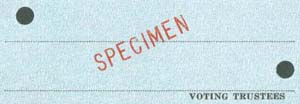
In the scripophily hobby, the term "specimen" refers to an example of a regular-issue certificate, usually marked in a manner to visibly render a certificate NOT viable as a security.
American Bank Note Company (ABNCo) was the premier engraver and printer of paper money, securities, and other documents. ABNCo and its subsidiaries normally marked their specimens in as many as three manners:
- a pair of small circular punches in the signature areas of certificates
- the word "SPECIMEN" stamped or printed in the signature areas of certificates
- obviously invalid serial numbers such as "00000" and less commonly "0000" or "000."
British printer and engraver Bradbury Wilkinson tended to mark its certificates with pinhole cancels in signature areas. Serial numbers were usually non-zero numbers in even increments of 1000. (1000, 2000, etc.) While not common, a few Bradbury Wilkinson specimens survive as representatives of securities for Canadian, Cuban, and British companies that operated in North America.
A few examples of specimens survive that were unmarked and identical in every respect to a regular certificates EXCEPT that they were perforated across the bodies. Those kinds of specimens are quite rare and easily destroyed by deteroration along the perforations.
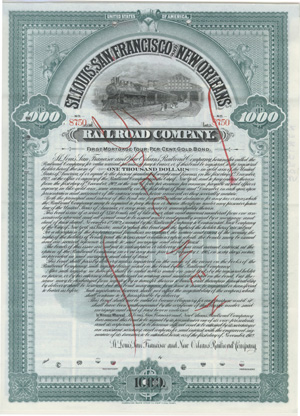
Smaller printing companies and generic certificate printers rarely made specimens. A few specimens survive that prove railroad companies often made their own specimens from regular production certificates. The example at right shows a handmade specimen of the St Louis San Francisco & New Orleans Railroad Company (courtesy of Sam Withers).
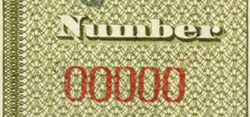
A number of specimens exist that were NOT marked with the typical "00000" serial number. A few are known to have been printed by ABNCo, but most originated with small and local printers. In the absence of normal specimen markings, some can be deduced as "unmarked specimens" when they display pairs of punch cancels in signature areas AND lack printed serial numbers. The possibility of their having served as specimens increases if all other unissued examples of the same variety display pre-printed serial numbers. Labelling an unmarked certificate as a "specimen" should not be done without compelling evidence.
Regardless of origin and regardless of markings, it is important for collectors to understand that specimens were ordinary, regular-issue certificates. They differed from full-fledged securities only by their special markings.
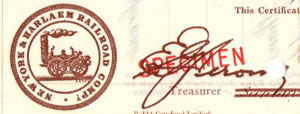
Large printing and engraving companies like ABNCo normally retained multiple specimens for their own file, comparison, and reproduction purposes. Front-line security printers probably retained specimens of every certificate they produced, no matter whether they were modifications from earlier printings nor whether those changes were major or minor. Even a change in a facsimile signature probably would have resulted in new specimens in a file drawer somewhere. Conversely, very few specimens of generic certificates have survived. (The portion of the New York & Harlem Rail Road Co. specimen shown at left probably resulted from a change in facsimile signatures. Courtesy of Thomas O'Shaughnessy.)
Beyond their internal purposes, major printers supplied unrecorded numbers of specimens to companies for corporate, compliance, and verification purposes. Some companies sent specimens to exchanges and clearing houses in order to capture counterfeits. While evidence is lacking, it seems reasonable to assume that specimens from some North American companies may have found their way into files at exchanges in Amsterdam, London, Paris, and Berlin.
Pricing
For many years, collectible specimens traded at noticeable premiums to regular issued certificates. Since about 2000, those price differences at auctions have all but disappeared. This is possibly a result of large numbers being freed into the collectors' market after the dispersal of American Bank Note Company holdings in the early 2000s.
Proofs also traded at noticeable premiums during the 1990s. Many sold in R.M. Smythe auctions during those years and have not yet resurfaced. These days, Archives International Auctions (AIA) regularly offers proofs in many of its sales. Major dealers usually maintain a few proofs in their inventories. Prices of proofs can be quite variable, due both to minimal supply, restricted numbers of collectors, and highly variable qualities of proofs. Sales reports are very spotty. Expect proofs to sell at prices both notably higher and lower than my estimates.
Rarity
There is simply no way to quantify the rarity of proofs other than to say that each is a one-of-a-kind item or nearly so. This project has rarely recorded the same proofs being sold twice. That includes even those proofs sold as early as the mid-1980s in sales by NASCA, a predecessor of Smythe. The view of this project is that when collectors consider buying proofs, they should realize they are buying unique or nearly unique collectibles. Proofs are acquirable, but NOT replaceable.
Some specimens are equally unreplaceable. Most are quite rare but not necessarily unique. I have stressed for years that huge numbers of cataloged varieties in this railroad database are known only in specimen form.
Many project correspondents ask how many specimens of specific varieties might exist. In my experience, the number is impossible to determine with accuracy. Archives International Auctions (AIA) frequently reports the number of specimen bonds encountered when it acquired a huge inventory of bonds from American Bank Note Company in 2002. I consider reports from AIA to be highly accurate for the specimens that remained in ABNCo files at the time they were disbursed to dealers. Beyond populations mentioned by AIA, it is not possible to say how many specimens exist for any single variety. Even reappearance of specimens in sales is unmeasurable because specimens normally display the same "00000" serial number. Based on offerings at professional auctions, eBay, and elsewhere, a few varieties are probably represented by ten or more specimens. In general, though, the majority of specimen varieties are probably represented by five or fewer examples. Records of this project show that many specimens have been offered only once in thirty years. If more examples exist, or if those near-unique specimens are selling more frequently than we can detect, their transactions are hidden behind private treaty sales.
It is the opinion of this project that the vast majority of specimens and proofs sell for SUBSTANTIALLY LESS than their rarities and conditions would otherwise suggest.
Collector avoidance of proofs and specimen
I don't see a problem with collectors who avoid collecting proof certificates. After all, there really aren't that many to collect. Some varieties are known only by proofs, but the number is so small that few specialized collections would be harmed by not including proofs.
It is a different story with specimens.
This project has recorded over a million reports of certificates that have appeared in correspondent collections, price lists, dealer offerings, professional auctions, and eBay sales. Specimens are known from 35% of all varieties. That is a high percentage. It makes it seem like specimens are common and easy to acquire.
Not only is that conclusion misleading, it presents an utterly false picture for collectors who strive for completeness.
Here are the facts.
Collecting is an individual pursuit. No one needs to justify how they form a collection. I know from correspondence that quite a few collectors don't want to buy specimens. I am NOT saying they are wrong. But I wonder whether they know the whole story of specimens.
The diagram on the left below shows the relative percentages of railroad certificates based on "type." Slightly over half of all cataloged varieties are cataloged as stock certificates.
The chart on the right shows the effect of removing all varieties that are represented only by specimens. Since so many varieties are known ONLY in specimen form, anyone who ignores specimens automatically eliminates for their collecting universe:
- 11% of all stock certificates
- 46% (!) of all bonds
- 20% of all "other" certificates
Yes, I know: that still leaves a LOT of certificates to collect! But here is the real problem for collectors who refuse to collect specimens.
Twenty percent (!) of all varieties of railroad certificates are known ONLY in specimen form.
That means one out of every five. Statistically, no matter the amount of money they have or the amount of time they spend searching, collectors will miss a tremendous number of incredible certificates if they avoid specimens.
It is true that very few specimens are known for certificates issued prior to the 1880s. Collectors of those certificates will not suffer much if they don't collect specimens.
But, for people who like to collect beautifully engraved certificates from the period of greatest rail expansion in North America, arguing against collecting specimens seems hard to justify.